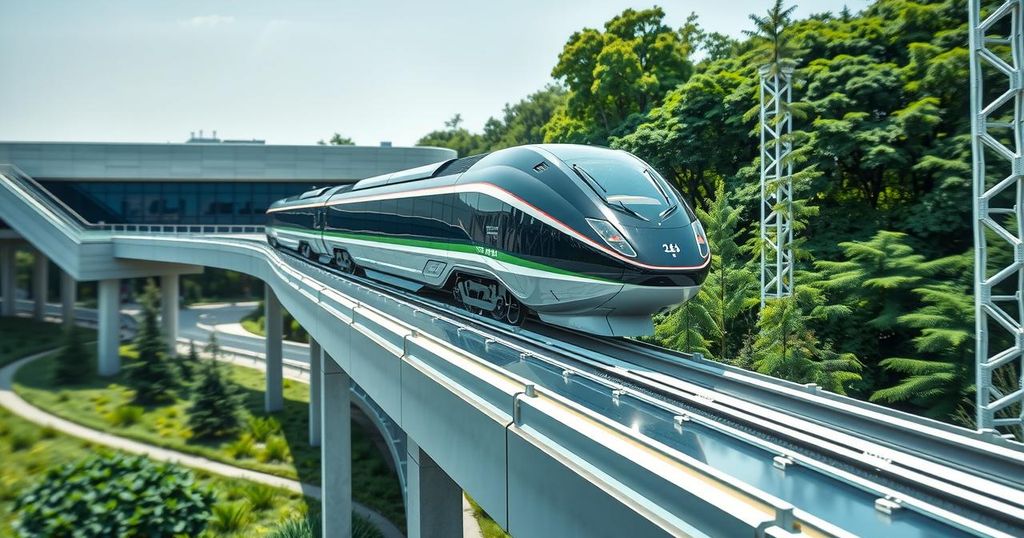China Pursues 373mph ‘Flying Train’ That Might Render HS2 Obsolete
- China is planning a revolutionary 373 mph ‘flying train’.
- The prototype maglev train could render HS2 obsolete before it opens.
- Maintenance and energy costs are significantly lower for maglev technology.
- Experts believe maglev technology will dominate high-speed rail worldwide.
- Current high-speed train services may take hours longer than proposed maglev systems.
China’s High-Speed Maglev Train Threatens HS2 Project Before Launch
China is set to make waves in high-speed travel with its ambitious plans for a revolutionary “flying train” aimed at reaching speeds of 600 km/h (373 mph). The state-owned China Railway Rolling Stock Corporation (CRRC) revealed a prototype magnetic levitation (maglev) train at the 17th Modern Railways exhibition in Beijing last week, generating significant buzz within the industry and raising questions about the future of Britain’s HS2 rail project. This new train boasts the ability to eliminate friction by hovering mere millimeters above the guideway, thus enabling it to exceed speeds of 200 mph, which is generally the limit for conventional trains. Immediate benefits include considerably lower maintenance costs, zero emissions from electric motors, and a remarkably quieter operation due to the absence of wheels, all of which position maglev trains as a formidable competitor to present high-speed rail options like HS2.
Experts Weigh In on Future of Maglev Technology
Maglev technology is still relatively new, with only seven operational services currently in place, primarily utilized for low-speed airport connections. Nevertheless, experts speculate that CRRC’s endeavor could see ultra-high-speed services implemented as soon as five years from now. This projection is particularly concerning given that HS2 is expected to commence service at 225 mph, just as Japan and China are racing to debut their maglev systems by the mid-2020s. Prof. Johannes Kluehspies from the International Maglev Board commented on the implications of this emerging technology, indicating that maglev’s advanced capabilities would render mainstay bullet trains, including Britain’s HS2, obsolete. He stated, “If the Chinese or Japanese succeed and start operations, it will mark the downturn of high-speed rail globally.”
Potential Impacts of Maglev on UK Rail
Journey times would be drastically improved with a maglev system, as exemplified in a proposed route connecting Beijing to Shanghai. Current travel time of four and a half hours on existing high-speed trains might shrink to a mere two and a half hours aboard the CRRC 600, a train that could cover distances of up to 1,300 miles at breakneck speeds. Not only would Europe benefit from similar connections, making trips from Rome to Berlin or London to Marseille feasible within hours, but domestic routes like London to Glasgow could potentially take as little as one and a half hours. Yet, the adoption of maglev in Britain is unlikely to happen rapidly, as the nation still grapples with the challenges posed by the HS2 project, particularly costs that could exceed £100 billion, pushing new technology to the backburner for the time being. Jeremy Acklam, a transport expert, confirmed that the UK remains cautious, favoring a wait-and-see approach until maglev technology is proven reliable in Japan or China.
Historical Context of Maglev Development in the UK
Britain historically played an important role in early maglev development, with notable contributions from inventor Eric Laithwaite during the post-war period. However, despite originating the world’s first commercial maglev service between Birmingham Airport and Birmingham International station in 1984, the UK has not since capitalized on its advancements in technology. Plans for an extensive UK maglev network connecting key cities were dashed after a tragic accident in Germany raised safety concerns and costs. In contrast, China is now eagerly pursuing its maglev aspirations, aided by its vast population and government support. But alongside this enthusiasm lies a global competition between China and Japan, with each country hoping to deploy the first ultra-high-speed maglev service. While Japan’s proposed service faced delays, China’s ambitions may very well eclipse existing high-speed options like HS2, indicating that the future of rail travel may lean more heavily toward maglev systems than ever before. With the evolution of technology at hand, the pressing question remains: can Britain’s HS2 project compete against these formidable innovations?
The advancement of maglev technology heralds a significant shift in high-speed rail travel, putting established projects like HS2 in jeopardy. As China and Japan ramp up their maglev initiatives, experts predict a future where traditional rail systems are displaced. The implications of this technological evolution are profound, posing both challenges and opportunities for the UK’s rail infrastructure as it must contend with increasingly capable competitors on the global stage.




Post Comment